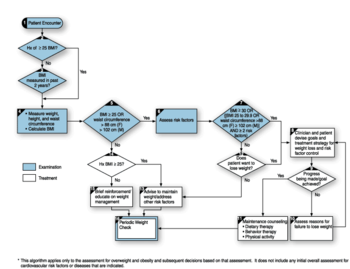Procedure

General components which are present in a diagnostic procedure in most of the various available methods include:
- Complementing the already given information with further data gathering, which may include questions of the medical history (potentially from other people close to the patient as well), physical examination and various diagnostic tests.
A diagnostic test is any kind of medical test performed to aid in the diagnosis or detection of disease. Diagnostic tests can also be used to provide prognostic information on people with established disease. - Processing of the answers, findings or other results. Consultations with other providers and specialists in the field may be sought.
There are a number of methods or techniques that can be used in a diagnostic procedure, including performing a differential diagnosis or following medical algorithms.:198 In reality, a diagnostic procedure may involve components of multiple methods.:204
Differential diagnosisedit
The method of differential diagnosis is based on finding as many candidate diseases or conditions as possible that can possibly cause the signs or symptoms, followed by a process of elimination or at least of rendering the entries more or less probable by further medical tests and other processing, aiming to reach the point where only one candidate disease or condition remains as probable. The final result may also remain a list of possible conditions, ranked in order of probability or severity. Such a list is often generated by computer-aided diagnosis systems.
The resultant diagnostic opinion by this method can be regarded more or less as a diagnosis of exclusion. Even if it does not result in a single probable disease or condition, it can at least rule out any imminently life-threatening conditions.
Unless the provider is certain of the condition present, further medical tests, such as medical imaging, are performed or scheduled in part to confirm or disprove the diagnosis but also to document the patient's status and keep the patient's medical history up to date.
If unexpected findings are made during this process, the initial hypothesis may be ruled out and the provider must then consider other hypotheses.
Pattern recognitionedit
In a pattern recognition method the provider uses experience to recognize a pattern of clinical characteristics.:198 It is mainly based on certain symptoms or signs being associated with certain diseases or conditions, not necessarily involving the more cognitive processing involved in a differential diagnosis.
This may be the primary method used in cases where diseases are "obvious", or the provider's experience may enable him or her to recognize the condition quickly. Theoretically, a certain pattern of signs or symptoms can be directly associated with a certain therapy, even without a definite decision regarding what is the actual disease, but such a compromise carries a substantial risk of missing a diagnosis which actually has a different therapy so it may be limited to cases where no diagnosis can be made.
Diagnostic criteriaedit
The term diagnostic criteria designates the specific combination of signs, symptoms, and test results that the clinician uses to attempt to determine the correct diagnosis.
Some examples of diagnostic criteria, also known as clinical case definitions, are:
- Amsterdam criteria for hereditary nonpolyposis colorectal cancer
- McDonald criteria for multiple sclerosis
- ACR criteria for systemic lupus erythematosus
- Centor criteria for strep throat
Clinical decision support systemedit
Clinical decision support systems are interactive computer programs designed to assist health professionals with decision-making tasks. The clinician interacts with the software utilizing both the clinician's knowledge and the software to make a better analysis of the patients data than either human or software could make on their own. Typically the system makes suggestions for the clinician to look through and the clinician picks useful information and removes erroneous suggestions.
Other diagnostic procedure methodsedit
Other methods that can be used in performing a diagnostic procedure include:
- Usage of medical algorithms
- An "exhaustive method", in which every possible question is asked and all possible data is collected.:198 This is often referred to as a diagnostic workup.
- Use of a sensory pill that collects and transmits physiological information after being swallowed.
- Using optical coherence tomography to produce detailed images of the brain or other soft tissue, through a "window" made of zirconia that has been modified to be transparent and implanted in the skull.
Comments
Post a Comment